Femia > Health Library > Getting Pregnant > Trying to conceive > 6 DPO: What to expect, and how to tell if you’re pregnant
6 DPO: What to expect, and how to tell if you’re pregnant
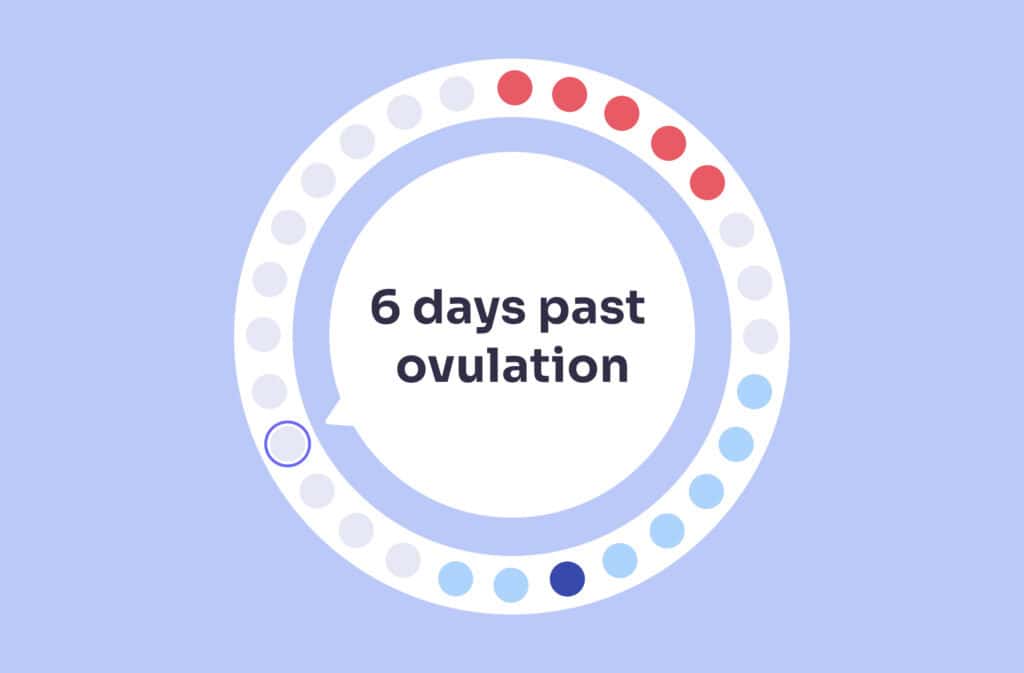
- Updated Feb 24, 2025
- Published
CRAFTED BY HUMAN
Crafted by human At Femia, we provide accurate and up-to-date information at every stage of your journey, from trying to conceive, pregnancy and postnatal support. All content is created by a real person based on in-depth research and own professional experience. Femia ensures that you will receive expert advice, strict accuracy and a personalized approach from our authors/medical experts. Learn more about our editorial policy.
FACT CHECKED
Fact checked At Femia Health, we maintain the highest standards of editorial excellence in delivering content focused on helping you conceive, guiding you through pregnancy, and supporting you postpartum. Explore our content review principles to learn how we ensure the accuracy and quality of our health and lifestyle tips for every stage of your journey.
At 6 DPO (6 days past ovulation):
- If fertilization occurred, the embryo continues to develop and may be preparing for implantation.
- Hormone levels, particularly progesterone, continue to rise.
- Some women may start to experience early pregnancy symptoms, though many won’t notice any changes yet.
- It’s still early for a pregnancy test, but some highly sensitive tests might detect pregnancy in rare cases.
Welcome to the 6 DPO milestone in your journey! At 6 days past ovulation, you’re in the heart of the luteal phase, a time of significant hormonal shifts and potential early changes if conception has occurred.
Remember, every woman’s body is unique, and there’s no one-size-fits-all experience at 6 DPO. So, let’s explore this moment in your cycle together, separating fact from fiction.
➡️ Read other Femia guides in this series:
- 1 DPO: What to expect, and how to tell if you’re pregnant
- 2 DPO: What to expect, and how to tell if you’re pregnant
- 3 DPO: What to expect, and how to tell if you’re pregnant
- 4 DPO: What to expect, and how to tell if you’re pregnant
- 5 DPO: What to expect, and how to tell if you’re pregnant
- 7 DPO: What to expect, and how to tell if you’re pregnant
- 8 DPO: What to expect, and how to tell if you’re pregnant
- 9 DPO: What to expect, and how to tell if you’re pregnant
- 10 DPO: What to expect, and how to tell if you’re pregnant
- 11 DPO: What to expect, and how to tell if you’re pregnant
- 12 DPO: What to expect, and how to tell if you’re pregnant
- 13 DPO: What to expect, and how to tell if you’re pregnant
- 14 DPO: What to expect, and how to tell if you’re pregnant
- 15 DPO: What to expect, and how to tell if you’re pregnant
- 16 DPO: What to expect, and how to tell if you’re pregnant
What does 6 DPO mean?
6 DPO stands for “6 days past ovulation.” If you’re trying to conceive (TTC), this is a crucial milestone in your journey. It marks the sixth day after your ovary releases an egg, and it’s a time when early pregnancy could be beginning, even if there are no outward signs yet.
At 6 DPO, you’re in the middle of the luteal phase – the second half of your menstrual cycle. This phase typically lasts about 14 days, but can range from 10 to 16 days. During this time, your body is preparing for the possibility of pregnancy, whether or not fertilization has actually occurred.
Remember, while the “typical” cycle is often described as 28 days with ovulation on day 14, everyone’s body is different. Your cycle length and ovulation day may vary, which is why tracking your individual patterns can be so helpful when TTC.
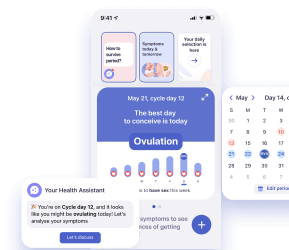
What's happening in your body at 6 DPO?
At 6 DPO, several important processes may be taking place in your body:
- Potential implantation. If fertilization has occurred, the embryo may be preparing to implant in the uterine lining. You may experience implantation around this time, though it more commonly occurs in a few days.
- Hormonal changes. Your body is continuing to produce increasing amounts of progesterone, which can cause various symptoms. Estrogen levels will continue to increase as you approach the middle of the luteal phase. When you get past the “middle” of the luteal phase, estrogen will decrease.
- Uterine lining changes. The lining of your uterus continues to thicken, preparing for potential implantation. This process is crucial for creating a nurturing environment for a potential pregnancy.
- Corpus luteum activity. The corpus luteum, formed from the ruptured follicle that released the egg, continues to produce progesterone. This hormone is essential for maintaining the uterine lining and supporting early pregnancy if conception occurs.
- Cervical changes. Your cervix may begin to change position and consistency. However, these changes can be subtle and aren’t a reliable indicator of pregnancy at this stage.
👉Find out more: How long after sex does implantation occur: Understanding the timeline
Common 6 DPO symptoms
While it’s still early, some women do report experiencing symptoms at this stage. Here are some common 6 DPO symptoms:
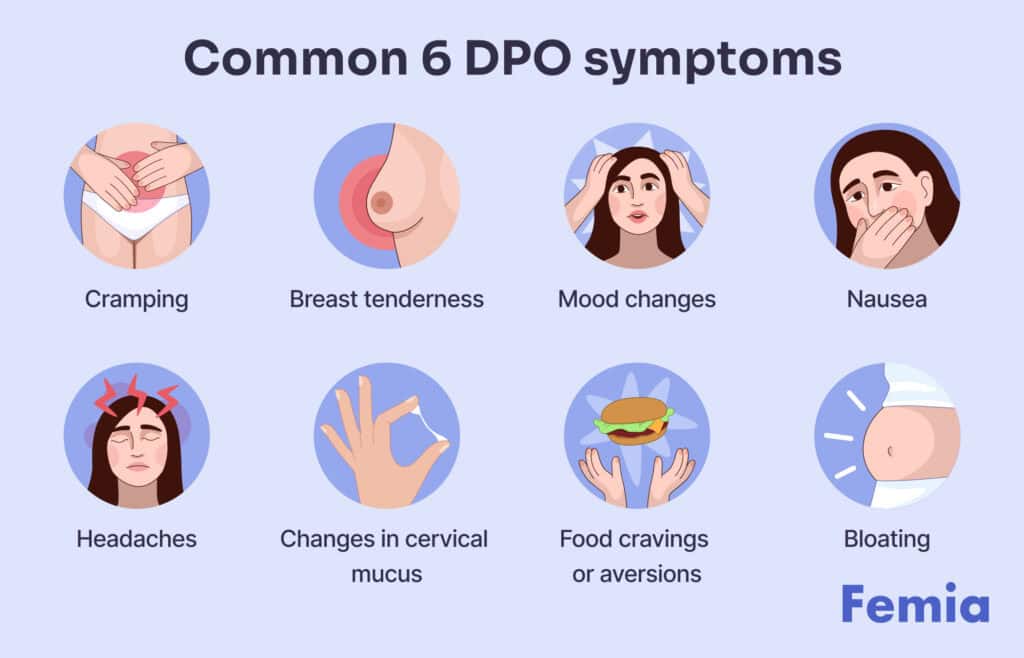
- Cramping. 6 DPO cramping is not uncommon. Cramping can be related to potential implantation or simply the normal effects of progesterone on your uterus. This cramping is usually mild and may feel similar to light menstrual cramps.
- Breast tenderness. Your breasts might feel sore or more sensitive than usual due to hormonal changes. Some women describe this as a feeling of fullness or heaviness in their breasts.
- Fatigue. You might feel more tired than usual as your body works hard to support a potential pregnancy. This fatigue can range from feeling slightly more sleepy than normal to being exhausted by mid-afternoon.
- Mood changes. Hormonal fluctuations can affect your mood, leading to irritability or emotional sensitivity. You might find yourself feeling more emotional or reactive than usual.
- Nausea. While it’s early, some women report experiencing 6 DPO nausea. This may be due to increasing hormone levels. However, it’s important to note that morning sickness typically doesn’t start until a few weeks into pregnancy.
- Changes in cervical mucus. 6 DPO cervical mucus might become thicker or creamier for some women. This change is due to the luteal phase’s increase in progesterone levels.
- Bloating. Some women experience bloating or a feeling of fullness in their abdomen. This can be due to hormonal changes affecting your digestive system.
- Headaches. Hormonal shifts sometimes trigger headaches for some women. These headaches are generally mild. If they are debilitating and keep you from your normal routine, we recommend consulting a healthcare provider.
- Food cravings or aversions. While it’s early, some women report changes in their food preferences. This can manifest as sudden cravings for certain foods or aversions to foods you usually enjoy.
- Increased urination. You might find yourself needing to use the bathroom more frequently. While this is a common early pregnancy symptom, at 6 DPO it’s more likely due to hormonal changes affecting your kidneys.
Remember, the presence or absence of these symptoms won’t definitively indicate whether or not you’re pregnant. Many of these symptoms can occur in non-pregnant cycles due to the normal hormonal fluctuations of the luteal phase.
6 DPO discharge
6 DPO discharge can vary from woman to woman. Some might notice:
- An increase in creamy, white discharge
- Thick, sticky discharge
- Little to no change in discharge
Changes in discharge aren’t a reliable indicator of pregnancy at this stage, as they are normal changes that can occur in non-pregnant cycles. The consistency and amount of discharge can be influenced by various factors, including hormone levels, hydration, and individual physiology.
If you’re tracking your cervical mucus as part of fertility awareness, you might notice it becoming thicker and less abundant than during your fertile window. This change is due to the increase in progesterone after ovulation.
👉Find out more: Ultimate pre-pregnancy checklist: Essential steps to take before having a baby
6 DPO symptoms if pregnant
While many 6 DPO symptoms if pregnant are similar to premenstrual symptoms, some women report:
- Heightened sense of smell
- Food aversions or cravings
- Bloating
- Mild headaches
- Lower back pain
- Slight temperature increase
- Tingling or soreness in breasts
- Feeling emotional or tearful
- Insomnia or vivid dreams
Remember, experiencing these symptoms doesn’t guarantee pregnancy, and many pregnant women don’t have noticeable symptoms this early. Every woman’s body responds differently to early pregnancy, and some may not experience any symptoms until several weeks after conception.
@femia.fertility When you're trying to conceive, you want to know if you're pregnant ASAP. Here's the answer to whether it's real or not #6dpo #implantation #ttc #ttccommunity #pregnancysign #earlypregnancysign #dreambaby #pregnancysymptom #usatiktok #pregnanttok #usa ♬ original sound - Femia fertility app
Can I take a 6 DPO pregnancy test?
Many women wonder about taking a 6 DPO pregnancy test. While it’s understandable to be eager, it’s generally too early for a reliable result. Here’s why:
- Implantation timing. Implantation usually occurs between 6-12 days after ovulation. At 6 DPO, it may not have happened yet for many women. Without implantation, your body won’t produce the pregnancy hormone hCG.
- hCG levels. Pregnancy tests detect human chorionic gonadotropin (hCG), which only starts being produced after implantation. Even if implantation has occurred, it takes time for hCG levels to rise sufficiently to be detected by a test.
- Test sensitivity. Most home pregnancy tests aren’t sensitive enough to detect the very low levels of hCG present immediately after implantation. While some ultra-sensitive tests claim to detect pregnancy earlier, they’re still unlikely to give accurate results at 6 DPO.
- Risk of false negatives. Taking a test this early is likely to result in a negative result, even if you are pregnant. This can lead to unnecessary disappointment and stress.
While it’s rare, some women do report getting a 6 DPO positive pregnancy test. However, these cases are the exception rather than the rule. For the most reliable results, it’s best to wait until at least the first day of your missed period before testing. If you can’t wait that long, try to hold off until at least 12-14 DPO for a more reliable result.
with confidence

Understanding early pregnancy test results
If you do decide to take a 6 DPO pregnancy test, it’s crucial to understand how to interpret the results:
| Negative result | A negative result at 6 DPO doesn't necessarily mean you're not pregnant. It could simply be too early for the test to detect hCG. If you still suspect you might be pregnant, wait a few days and test again. |
| Positive result | While rare, a positive result at 6 DPO could indicate pregnancy. However, it's important to confirm this result with another test in a few days and consult with your healthcare provider. |
| Faint line | If you see a very faint line, it could potentially indicate early pregnancy. However, it could also be an evaporation line or a false positive. It's best to wait and retest in a few days for confirmation. |
Remember, the most accurate results come from testing after your missed period. If you’re unsure about your test results or have any concerns, don’t hesitate to reach out to your healthcare provider for guidance.
6 DPO symptoms success stories
Some women share 6 DPO symptoms success stories, reporting early signs that they later attributed to pregnancy. These often include:
- Unusual fatigue
- Specific food cravings or aversions
- A “feeling” of being pregnant
- Increased urination
- Vivid dreams
- Sudden mood swings
- Metallic taste in the mouth
- Twinges or pulling sensations in the lower abdomen
Of course, it’s totally natural to be on high alert for any possible signs of successful conception. We’ve all been there, analyzing every twinge and mood swing. But remember that your body is going through its normal cycle changes right now, pregnant or not, and many of these symptoms can pop up either way.
The most reliable pregnancy detector isn’t a super-sensitive nose or a sudden craving for pickles and ice cream. It’s still that good ol’ pregnancy test, taken at the right time. And if it turns out positive? That’s when the real excitement begins, kicking off with a visit to your healthcare provider.
So, while it’s fun to symptom-spot (and hey, we all do it!), try not to put too much pressure on yourself to “feel” pregnant just yet. Your body will let you know when it’s ready, in its own perfect time. Until then, be kind to yourself, stay hopeful, and remember—one symptom, multiple symptoms, or a lack thereof doesn’t define your journey. You’ve got this!
Questions from the Femia community
Is cramping at 6 DPO a sign of pregnancy?
Cramping at 6 DPO can occur whether you're pregnant or not. It could be related to potential implantation, but it can also be a normal part of your menstrual cycle. Cramping alone isn't a reliable indicator of pregnancy.
Can 6 DPO cramping be a sign of successful implantation?
While 6 DPO cramping could potentially signal implantation, it's on the early side. Implantation usually occurs between 6-12 DPO. Cramping at this time might simply be your body's normal post-ovulation process. It's best to note any changes in your symptom diary, if you keep one, but try not to draw conclusions just yet. Your body will provide more clues in the coming days.
Is 6 DPO nausea different from regular PMS nausea?
At 6 DPO, it's challenging to distinguish between early pregnancy nausea and PMS nausea. They can feel quite similar! The main difference is that pregnancy-related nausea tends to persist and may intensify over time, while PMS nausea typically resolves when your period starts. Remember, feeling nauseous at 6 DPO doesn't necessarily indicate pregnancy – our bodies can be quite mysterious sometimes!
The bottom line
At 6 DPO, your body is continuing to prepare for the possibility of pregnancy. While some women may start to notice early symptoms, many won’t feel any different at this stage. It’s generally too early for a reliable pregnancy test, so the best approach is to continue taking care of yourself and try to remain patient.
Remember, whether you’re experiencing cramping, changes in discharge, or other symptoms, your journey is unique. The two-week wait between ovulation and your expected period can be an emotionally challenging time, but you’re not alone in this experience. Many women go through similar feelings of hope, anxiety, and impatience during this time after ovulation.
As you navigate this waiting period, try to focus on self-care and activities that bring you joy and relaxation. Whether this cycle results in pregnancy or not, be kind to yourself and remember that your worth is not defined by your fertility journey.
Stay hopeful, but also realistic. While it’s exciting to look for early signs of pregnancy, the most reliable way to confirm pregnancy is still through a properly timed pregnancy test and a follow-up with your healthcare provider. Until then, take things one day at a time and trust that your body is doing what it needs to do.
➡️ Read other Femia guides in this series:
- 1 DPO: What to expect, and how to tell if you’re pregnant
- 2 DPO: What to expect, and how to tell if you’re pregnant
- 3 DPO: What to expect, and how to tell if you’re pregnant
- 4 DPO: What to expect, and how to tell if you’re pregnant
- 5 DPO: What to expect, and how to tell if you’re pregnant
- 7 DPO: What to expect, and how to tell if you’re pregnant
- 8 DPO: What to expect, and how to tell if you’re pregnant
- 9 DPO: What to expect, and how to tell if you’re pregnant
- 10 DPO: What to expect, and how to tell if you’re pregnant
- 11 DPO: What to expect, and how to tell if you’re pregnant
- 12 DPO: What to expect, and how to tell if you’re pregnant
- 13 DPO: What to expect, and how to tell if you’re pregnant
- 14 DPO: What to expect, and how to tell if you’re pregnant
- 15 DPO: What to expect, and how to tell if you’re pregnant
- 16 DPO: What to expect, and how to tell if you’re pregnant
References
- Practice Committee of the American Society for Reproductive Medicine. “Optimizing Natural Fertility: A Committee Opinion.” Fertility and Sterility, vol. 107, no. 1, 2017, pp. 52-58. National Library of Medicine, https://pubmed.ncbi.nlm.nih.gov/28228319/.
- Wilcox, Allen J., et al. “Time of Implantation of the Conceptus and Loss of Pregnancy.” New England Journal of Medicine, vol. 340, no. 23, 1999, pp. 1796-1799. National Library of Medicine, https://www.nejm.org/doi/full/10.1056/NEJM199906103402304.
- American College of Obstetricians and Gynecologists. “Early Pregnancy Loss.” ACOG Practice Bulletin No. 200, 2018. https://www.acog.org/clinical/clinical-guidance/practice-bulletin/articles/2018/11/early-pregnancy-loss.
- National Institutes of Health. “What are some common signs of pregnancy?” National Institute of Child Health and Human Development, 2017. https://www.nichd.nih.gov/health/topics/pregnancy/conditioninfo/signs.
- Mayo Clinic Staff. “Home pregnancy tests: Can you trust the results?” Mayo Clinic, 2022. https://www.mayoclinic.org/healthy-lifestyle/getting-pregnant/in-depth/home-pregnancy-tests/art-20047940.
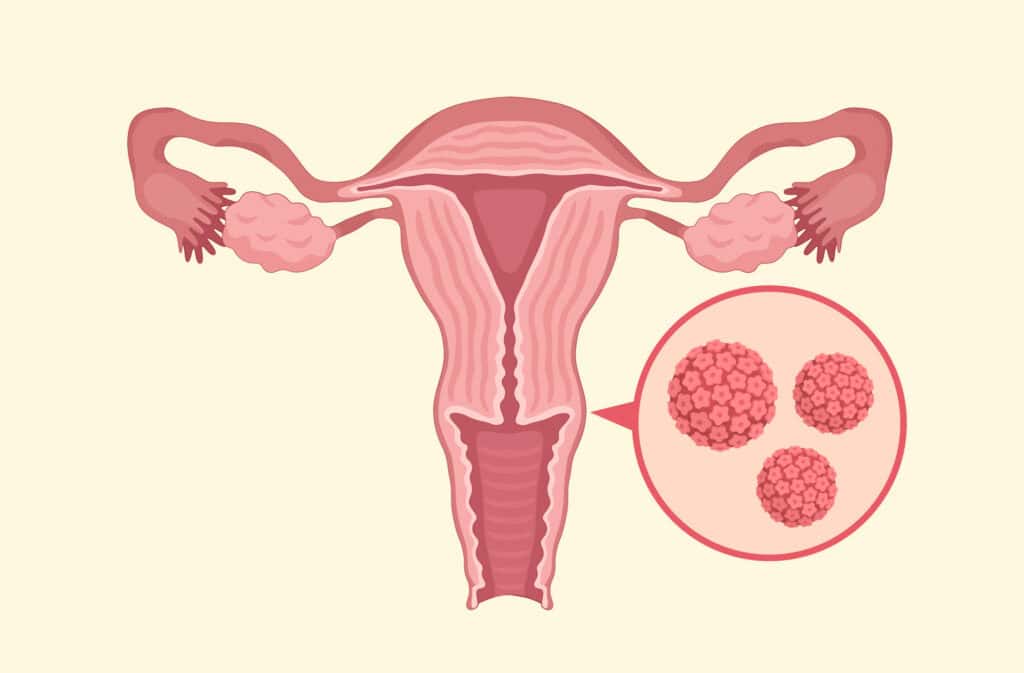
Can HPV cause infertility? Discover the impact of HPV on fertility and pregnancy outcomes in detail and the measures to prevent HPV from the mother to the baby.
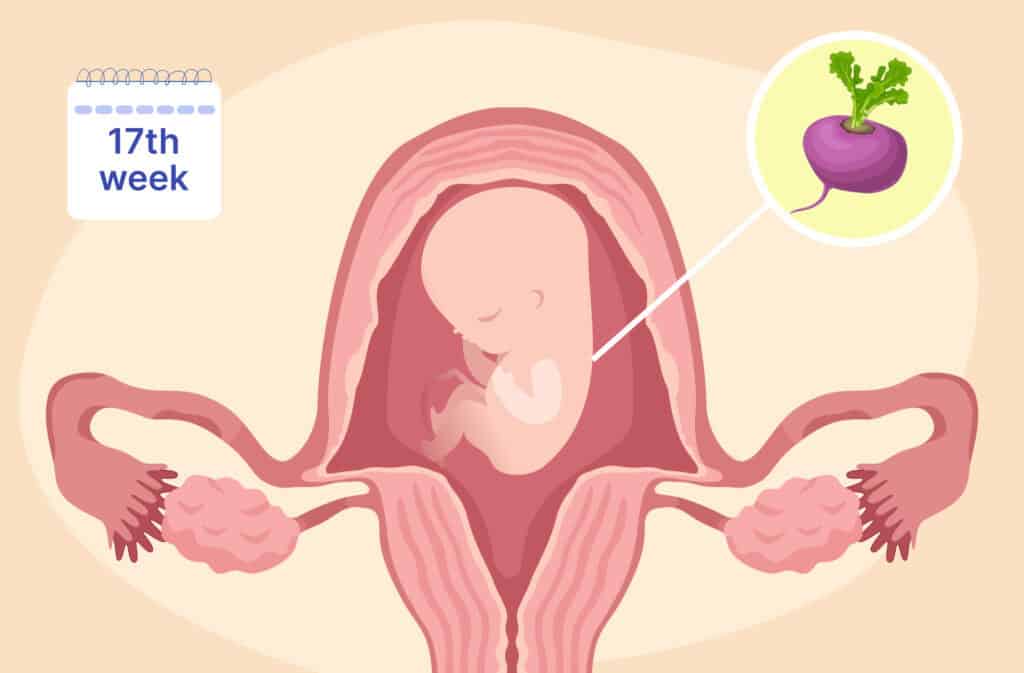
Discover what’s happening at 17 weeks pregnant, from baby’s position and size to symptoms, ultrasound details, and helpful self-care tips.

Why is my discharge brown? Find a comprehensive guide to understand the causes and meanings of brown discharge and know when to see a doctor.

